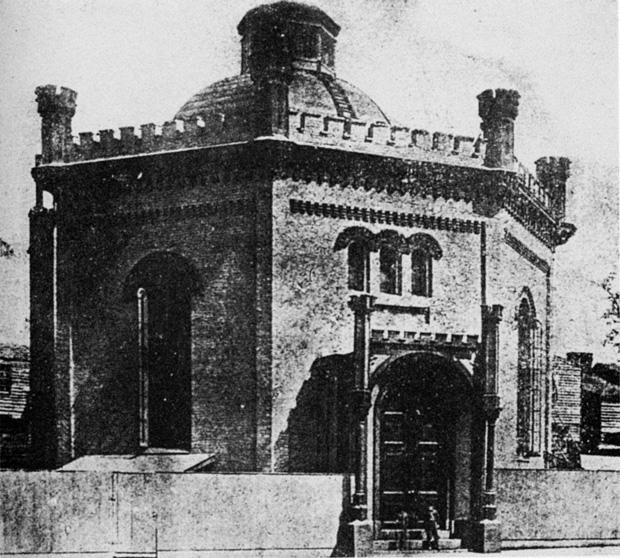St. Louis’ first synagogue building: B’nai El at Sixth and Cerre
Published February 21, 2014
As part of this year’s community-wide celebration of the 250th anniversary of the founding of St. Louis in 1764, Cohnipedia has been focusing on several local Jewish “firsts.” Today’s installment looks at the first area synagogue to construct a permanent synagogue building. That distinction belongs to B’nai El Congregation, which was officially founded on Oct. 17, 1852 as a result of a merger between two small congregations, Emanu-El (1847) and B’nai B’rith (1849). (These synagogues had no connection to the fraternal order of B’nai B’rith or to St. Louis’s present Temple Emanuel. The merged congregation incorporated both names into their new moniker.)
According to “Zion in the Valley,” Walter Ehrlich’s definitive history of the Jewish community of St. Louis, there was a brief period in which B’nai El and United Hebrew discussed a possible merger, though the talks were soon called off. United Hebrew is the oldest synagogue in our community but not the first to construct a permanent synagogue building.
While both B’nai B’rith and Emanu-El congregations favored traditional Jewish practices, their memberships were relatively more liberal in their Judaism than United Hebrew. B’nai El’s constitution and by-laws “acknowledged the liberal tendencies of the newly immigrating German Jews and their desire to acculturate,” writes Ehrlich
Once B’nai El had established itself as a viable congregation, it set about the task to build a synagogue to serve both as a house of worship and as a religious school. B’nai El initially occupied temporary rented quarters, originally two small rooms, on the corner of Lafayette and Ninth streets. Later, it moved to larger rented facilities at Seventh Street and Park Avenue, a building known as Decker’s House. Daniel Block, an influential member of B’nai El, prevailed in his view that the congregation should purchase a tract of land and construct its synagogue there.
We learn from Ehrlich and B’nai El’s detailed archives that in October 1853, Abraham S. Jacobs, who had recently joined B’nai El, offered the congregation a parcel of land at its original cost and at half its then market value. The parcel was located on the east side of Sixth Street, between Gratiot and Cerre streets, closer to the latter, with a 70-foot front and 75-foot depth. The price was $34 a front foot, or $2,380: $380 in cash and notes for $2,000. There was also an officially approved stipulation that the property would “never be used for anything else than a Temple building.”
The young B’nai El congregation faced difficulties in raising sufficient funds for the project even though there were generous gifts from the local Catholic and Presbyterian communities towards the project. The situation led to resumed merger discussions with United Hebrew until 1854, when the wealthy New Orleans Jewish philanthropist Judah Touro left bequests to the Jewish poor in Jerusalem as well as several bequests to various U.S. congregations, including B’nai El.
Ehrlich says that the Touro legacy “spurred B’nai El into action,” and that throughout the remainder of 1854 sufficient funds had been raised. In early 1855, the congregation approved plans by Koenig and Brothers, Architects at a cost of $6,600.
On April 16, 1855, 10 years (nearly to the day) before the death of President Abraham Lincoln, the cornerstone ceremony took place at the site, which was attended by St. Louis Mayor Washington King and Rabbi Bernard Illowy, recently engaged rabbi of United Hebrew. B’nai El president Bernard Singer introduced local businessman Isidor Bush, who offered a brief history of how B’nai El resulted from the merger of the two smaller congregations.
After a construction period in the summer of 1855, which was besieged with various complaints regarding the layout, quality of the construction and painting, the building was ready for occupancy in September. Impressive dedication services were held on Sept. 7, 1855. The sanctuary was packed with Jewish community leaders along with B’nai El congregants and members of other religious groups. At 3 p.m., President Singer ceremonially opened the front doors. Isidor Bush delivered an address in English, and UH Rabbi Illowy preached a sermon in German.
There is only one known photograph of B’nai El’s Sixth and Cerre streets synagogue, an exterior shot taken in 1858. It shows an octagonal-shaped building, 50-feet across, topped by a domed building, which was described at the time as resembling a “conventional Turkish mosque.” Others compared its unique shape to a “pepper pot” or a “coffee mill.” An organ was later installed in the building, which Ehrlich calls “a significant leaning within B’nai El towards liberalism, and later Reform, a movement which B’nai El would join within a few decades.
The Sixth and Cerre streets location would serve B’nai El from 1855 to 1906, when the synagogue moved to a new building at Spring and Flad streets, which it used from 1906 to 1930. From 1930 to 1965, B’nai El was located at Clara Street and Delmar Boulevard, after which the temple moved to its ultimate location on 11411 North Outer 40 Road. It remained there until B’nai El shuttered its building and consolidated with Congregation Shaare Emeth, becoming the B’nai El Collaborative, housed on the Shaare Emeth campus.
The Sixth and Cerre streets original site was demolished, but all three of the subsequent B’nai El buildings remain standing to this day.















